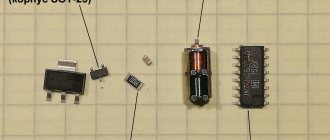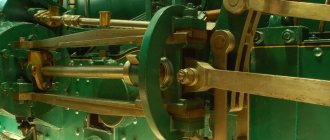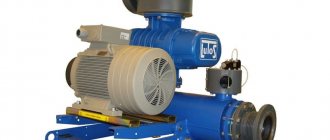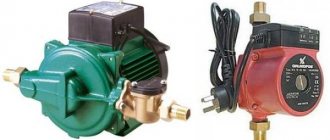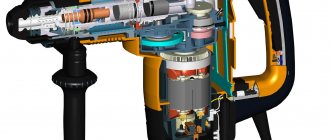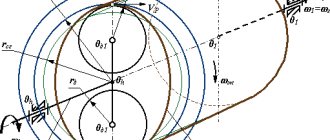The working cycle of an internal combustion engine is a periodically repeating series of sequential processes occurring in each working cylinder. The main task of the work process is to convert thermal energy from the combustion of the working fluid into mechanical work, in particular into the rotational movement of the crankshaft. Car engines most often operate on a four-stroke cycle, which is completed in two revolutions of the crankshaft or four strokes of the piston and consists of intake, compression, expansion and exhaust strokes.
In a carburetor four-stroke engine, the operating cycle occurs as follows.
Carburetor engine duty cycle:
— Intake stroke
During this stroke, the piston descends from top dead center (TDC) to bottom dead center (BDC). At this time, the camshaft cams open the intake valve, and through this valve a fresh fuel-air mixture is sucked into the cylinder.
— Compression stroke
The piston moves from BDC to TDC, compressing the working mixture. In this case, the temperature of the mixture increases significantly. The ratio of the working volume of the cylinder at BDC to the volume of the combustion chamber at TDC is called the compression ratio. The compression ratio is a very important parameter; usually, the higher it is, the greater the fuel efficiency of the engine. However, an engine with a higher compression ratio requires higher octane fuel, which is more expensive. Expansion stroke, or power stroke
Shortly before the end of the compression cycle, the air-fuel mixture is ignited by a spark from the spark plug. As the piston moves from TDC to BDC, the fuel burns and, under the influence of the heat of the burned fuel, the working mixture expands, pushing the piston. When gases expand, they do useful work, so the stroke of the piston during this stroke of the crankshaft is called the “power stroke.” It is almost impossible to completely clean the engine cylinders from combustion products, therefore, with the subsequent intake of a fresh combustible mixture, it moves with residual exhaust gases and is called the “working mixture”. The degree to which the engine crankshaft is “underrotated” to TDC when the mixture is ignited is called the ignition timing angle. Ignition timing is necessary so that fuel combustion has time to completely end by the time the piston reaches BDC, that is, for the most efficient operation of the engine. Fuel combustion takes almost a fixed time, so to improve engine efficiency, you need to increase the ignition timing as the speed increases. In older engines, this adjustment was made by a mechanical device (centrifugal and vacuum regulator acting on a chopper). Modern engines use electronics to adjust the ignition timing.
Watch the animation, it clearly demonstrates the operation of a four-stroke engine.
— Release stroke
After BDC of the operating cycle, the exhaust valve opens and the upward moving piston forces the exhaust gases out of the engine cylinder. When the piston reaches TDC, the exhaust valve closes and the cycle begins again.
How to diagnose the condition of the engine by the color of the exhaust gases, read the corresponding article.
The residual gas coefficient characterizes the degree of contamination of the fresh charge with exhaust gases and is the ratio of the mass of combustion products remaining in the cylinder to the mass of the fresh combustible mixture. For carburetor engines, the residual gas coefficient is in the range of 0.06-0.12.
In relation to the power stroke, the intake, compression and exhaust strokes are auxiliary.
History of creation
In the 18th century, many inventors worked to create power units that could replace the steam engine. The appearance of devices in which fuel would not be burned in a furnace, but directly in the engine cylinder, became possible after the French inventor Philippe Le Bon discovered illuminating gas in 1799. Two years later, he also designed a gas power unit, where the gas-air mixture was ignited in the cylinder. It had 1 double-acting working cylinder (combustion chambers were located on both sides of the piston, and the working mixture in them was ignited alternately). And only many years later a more advanced four-stroke engine appeared, which found wide application in many industries.
Such an engine was first demonstrated by the German engineer August Otto in 1877. This happened after the Belgian inventor Jean Etienne Lenoir proposed igniting a combustible mixture using an electric spark. Its appearance was also facilitated by the invention of a device that made it possible to evaporate liquid fuel and ensure the preparation of a working gas-air mixture (carburetor).
Serial production of four-stroke gasoline engines began in 1883. Then the German engineer Gottlieb Daimler proposed using hot tubes inserted inside the cylinders to ignite the gas-air mixture.
In a four-stroke diesel engine, working processes occur as follows
— Intake stroke
When the piston moves from TDC to BDC, due to the resulting vacuum, atmospheric air enters the cylinder cavity through the open intake valve.
— Compression stroke
The piston moves from BDC to TDC. The intake and exhaust valves are closed, as a result of which the upward moving piston compresses the air present in the cylinder. For fuel to ignite, the temperature of the compressed air must be higher than the auto-ignition temperature of the fuel.
— Expansion stroke, or power stroke
As the piston approaches TDC, diesel fuel is injected into the cylinder through a nozzle, supplied by a high-pressure fuel pump (HPF). The injected fuel, mixing with heated air, self-ignites and the combustion process begins, characterized by a rapid increase in temperature and pressure. Under the influence of gas pressure, the piston moves from TDC to BDC. A working process is taking place.
— Release stroke
The piston moves from BDC to TDC and the exhaust gases are pushed out of the cylinder through the open exhaust valve. After the end of the exhaust stroke, with further rotation of the crankshaft, the working cycle is repeated in the same sequence.
Study and read thermal and dynamic calculations of 4-stroke internal combustion engines in this free program
This video shows the operation of a real engine. The camera is built into the cylinder of the block.
Unit design
The camshaft of a four-stroke engine is located in the cylinder cover. It is driven by a drive wheel mounted in the crankshaft. The camshaft opens and closes one of the valves: exhaust or intake, depending on the location of the piston. The camshaft also contains cams that operate the valve rocker arms.
Once triggered, the rocker arms It is important that there must be a thermal gap (narrow gap) between the adjusting screw and the valve. When heated, the metal expands, so if the gap is too small or there is none at all, the valves cannot completely close the exhaust and intake passages.
at the intake valve should be smaller than at the exhaust valve, because the exhaust gases are hotter than the mixture. Accordingly, the intake valve heats up less than the exhaust valves.
Disadvantages of four-stroke engines:
All idle strokes (intake, compression, exhaust) are accomplished using the kinetic energy stored by the crank mechanism and associated parts during the power stroke, during which the chemical energy of the fuel is converted into mechanical energy of the moving parts of the engine. Since combustion occurs in fractions of seconds, it is accompanied by a rapid increase in the load on the cylinder cover (head), piston and other parts of the internal combustion engine. The presence of such a load inevitably leads to the need to increase the mass of moving parts (to increase strength), which in turn is accompanied by an increase in inertial loads on moving parts.
Disadvantages include the need to adjust the thermal clearance of the valves, a larger number of parts and, accordingly, each of them will need to be replaced with a working one at some point. Four-stroke internal combustion engines are larger, their parts are more voluminous and complex. To carry out repairs of such engines, it is necessary to use heavy garage equipment: tilting stands, stands for repairing internal combustion engines, a crane, etc.
What are dead spots and engine cycles?
The number of stages included in one working cycle of an internal combustion engine (ICE) is usually calculated based on the number of piston strokes in the cylinder. These stages are called engine strokes. The stroke of the piston is directly determined by its movement from one extreme point to another. They are called dead, because if the piston stops at such a point, it will not be able to start moving without external influence. In simple words, dead points are positions at which the movement in the current direction of the piston stops and it begins to reverse.
Dead spots and piston stroke of internal combustion engines
There are two dead spots:
- Lower (BDC) – the position at which the distance between the piston and the axis of rotation of the crankshaft is minimal.
- Top (TDC) - the position at which the cylinder is at the maximum distance from the axis of rotation of the engine crankshaft.
In English-language documentation, TDC is designated as TDC (Top Dead Center), and BDC is designated BDC (Bottom Dead Center).
There are engines whose operating cycle can consist of two or four strokes. Based on this, they are divided into two-stroke and four-stroke engines.
Advantages of four-stroke engines:
- Economical fuel consumption due to fewer working strokes per unit of time;
- Reliability is due to the thermal regime, which is softer in 4-stroke internal combustion engines;
- The engine is much quieter than its two-stroke counterpart.
Unlike a two-stroke engine, in which the crankshaft, crankshaft bearings, compression rings, piston, piston pin and cylinder are lubricated by adding lubricant to the fuel, the crankshaft of a four-stroke engine is force-lubricated by pressure. Significantly less carbon deposits form on the piston surface, muffler walls and exhaust system. In addition, in a 2-stroke engine, the fuel mixture is released into the exhaust pipe and affects the environment. The environment has a separate problem. 
How does cooling work?
The cooling system in most cars consists of a radiator and a water pump. Water circulates through passages (channels) around the cylinders and then passes through the radiator to cool it as much as possible. However, there are some car models (most notably the Volkswagen Beetle), as well as most motorcycles and lawn mowers, that have an air-cooled engine. You've probably seen those air-cooled engines that have fins on the side—a ridged surface that lines the outside of each cylinder to help dissipate heat.
Air cooling makes the engine lighter but hotter, and generally reduces engine life and overall performance. So now you know how and why your engine stays cool.
Inlet
So, in the combustion chamber of a power unit, energy conversion cycles begin with the combustion reaction of the fuel mixture. In this case, the piston is at its highest point (TDC position), and then moves down. As a result, a vacuum occurs in the combustion chamber of the engine. Under its influence, the flammable liquid sucks in fuel. The inlet valve is in the open position, and the outlet valve is closed.
When the piston begins to move downward, the volume above it increases. This causes vacuum. It is approximately 0.071-0.093 MPa. Thus, gasoline enters the combustion chamber. In injection engines, fuel is injected by an injector. After the mixture enters the cylinder, its temperature can be 75 to 125 degrees.
Features of the four-stroke engine lubrication system
The design of the four-stroke power unit includes an oil sump with a sump, which constantly contains lubricating fluid at a certain level. Using an oil pump, engine lubricant enters the system and is distributed over the internal surfaces of the cylinder walls.
A thin oil film significantly reduces the friction force of contacting moving elements. Oil scraper rings carefully remove engine oil from the combustion chamber.
Thanks to the lower loads experienced by a 4-stroke engine, a systematic supply of lubricant in the required volumes to the rubbing surfaces of working parts and assemblies is ensured. Due to this, the engine resource is significantly increased. A complete engine oil change should be done once a season.
To prevent possible leaks of engine oil from the internal combustion engine during operation of the power unit, it is necessary to regularly measure the amount of lubricating fluid in the crankcase using a special oil dipstick.
On modern car models, manufacturers install special control sensors, with the help of which they check the level of engine lubrication and immediately inform the driver about the need for a complete replacement of the lubricant.

